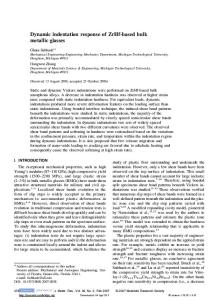Effect of dilatation on the elasto-plastic response of bulk metallic glasses under indentation
- PDF / 313,241 Bytes
- 5 Pages / 612 x 792 pts (letter) Page_size
- 35 Downloads / 396 Views
1224-GG04-07
Effect of dilatation on the elasto-plastic response of bulk metallic glasses under indentation Anamika Prasad1, Ming Dao2, and Upadrasta Ramamurty3 1
Department of Bioengineering, Stanford University, Palo Alto, USA Department of Materials Science and Engineering, MIT, Cambridge, USA 3 Department of Materials Engineering, Indian Institute of Science, Bangalore, India 2
ABSTRACT Unlike metals, elasto-plastic response of bulk metallic glasses (BMGs) follows closely that of granular materials through pressure dependent (or normal stress) yield locus and shear stress induced material dilatation. While on a micro-structural level, material dilatation is responsible for stress-softening and formation of localized shear band, its influence on the macro-scale flow and deformation is largely unknown. In this work, we systematically analyze the effect of material dilatation on the gross indentation response of Zr-based BMG via finite element simulation. The strengthening/softening effect of load-depth response and corresponding stress-strain profiles are presented in light of differences in elastic-plastic regimes under common indenters. Through comparison of the numerical predictions with existing experimental data, we draw conclusions to guide the selection of a suitable dilatation parameter for accurately predicting the gross response of BMGs. INTRODUCTION Bulk metallic glasses (BMGs) have gained considerable scientific and practical importance due to their unique combinations of mechanical properties [1]. This has opened up new avenues for their structural applications [2] and hence greater need for understanding the mechanical response of BMGs at different length scales, and for developing accurate predictive capabilities. On a macro-scale level, it is now commonly agreed that their plastic yield condition is better predicted using the pressure sensitive (or normal stress sensitive) yield criteria such as the Drucker-Prager (or the Mohr-Coulomb) model [3]. However, the flow rule or the plastic flow condition beyond yield is not clearly agreed upon and is the focus of the current study. We systematically investigate the effect of different plastic flow conditions for the Drucker-Prager (DP) yield criteria. Specifically, we focus on the effect of variation in dilatation angle on the gross indentation response of BMGs through numerical simulation and compare the predictions with existing experimental data to guide the selection of a suitable material parameter. FINITE ELEMENT AND THE MATERIAL MODEL Conical (apex angle of 900 and 140.60) and pyramidal indentation (Berkovich and Vickers indenter) analysis was performed using the general-purpose FEM package ABAQUS Standard (SIMULIA, Providence, RI, USA). Axisymmetric two-dimensional mesh was used for conical indentation, while a full three-dimensional mesh was used for pyramidal indentation, with the mesh size being optimized for result accuracy. For all cases, at least 10 to 15 elements were in contact with the indenter at full indentation depth. A typical mes
Data Loading...











